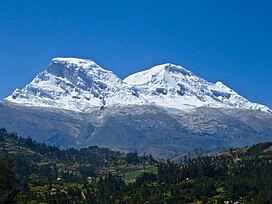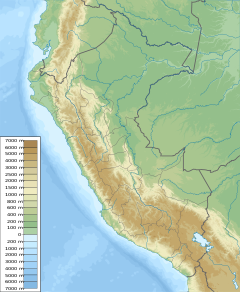geo.wikisort.org - Mountains
Huascarán (Spanish pronunciation: [waskaˈɾan]) (Quechua: Waskaran), Nevado Huascarán or Mataraju is a mountain in the Peruvian province of Yungay (Ancash Department), situated in the Cordillera Blanca range of the western Andes. The southern summit of Huascarán (Huascarán Sur), which reaches 6,768 metres (22,205 ft), is the highest point in Peru, the northern Andes (north of Lake Titicaca), and in all of the earth's Tropics. Huascarán is the fourth highest mountain in the Western Hemisphere and South America after Aconcagua, Ojos del Salado, and Monte Pissis, respectively.
| Huascarán | |
|---|---|
 Huascarán as viewed from Callejón de Huaylas | |
| Highest point | |
| Elevation | 6,768 m (22,205 ft)[1] |
| Prominence | 2,776 m (9,108 ft)[2] |
| Isolation | 2,196 km (1,365 mi) |
| Listing | Country high point Ultra |
| Coordinates | 09°07′18″S 77°36′15″W[2] |
| Geography | |
 Huascarán Peru | |
| Location | Yungay, Peru |
| Parent range | Cordillera Blanca |
| Geology | |
| Age of rock | Cenozoic |
| Mountain type | Granite |
| Climbing | |
| First ascent | Huascarán Sur: 20 July 1932 - Huascarán Norte: 2 September 1908 |
| Easiest route | glacier/snow/ice climb |
Name
Until the 20th century, the mountain lacked a single commonly accepted name but it was rather known by different names within the surrounding towns and villages. The first recorded mention of the name Huascaran appeared in 1850 as Huascan,[3] name given by the local people likely because the mountain rises above the village of Huashco, Huashco getting its name from the Quechua word for rope (waska). At the beginning of the 20th century, the name appeared as Huascarán, a form which has not since changed.[4] It seems that the name Huascarán is merely a contraction of Huashco-Urán. When the mountain was mentioned, it was thought of in connection with the village and was called Huashco-Urán or “Beyond and down from the village of Huashco.”[5]
Other names given to the mountain were Matarao and Mataraju, Mataraju being the name by which the local indigenous inhabitants prefer to call the mountain,[6] from Ancash Quechua mata (twin) and rahu (snow peak), meaning 'twin snow peaks'.
Geography
The mountain has two distinct summits, the higher being the south one (Huascarán Sur) with an elevation of 6,768 metres (22,205 ft).[1] The north summit (Huascarán Norte) has an elevation of 6,654 meters (21,831 ft).[1] The two summits are separated by a saddle (called 'Garganta'). The core of Huascarán, like much of the Cordillera Blanca, consists of Cenozoic granite.[7]
Huascarán gives its name to Huascarán National Park which surrounds it, and is a popular location for trekking and mountaineering. The Huascarán summit is one of the points on the Earth's surface farthest from the Earth's center,[8] closely behind the farthest point, Chimborazo in Ecuador.[1]
The summit of Huascarán is the place on Earth with the smallest gravitational force.[9]
Climbing
Huascarán is normally climbed from the village of Musho to the west via a high camp in the col that separates the two summits, known as La Garganta. The ascent normally takes five to seven days, the main difficulties being the large crevasses that often block the route.[10] The normal route is of moderate difficulty and rated between PD and AD (depending on the conditions of the mountain) according to the International French Adjectival System.
On July 20, 2016, nine climbers were caught in an avalanche on Huascarán's normal route at approximately 5,800 m (19,000 ft), four of whom died.[11]
History
The summit of Huascarán Sur was first reached on 20 July 1932 by a joint German–Austrian expedition.[12] The team followed what would become later the normal route (named today Garganta route). The north peak (Huascarán Norte) had previously been climbed on 2 September 1908 by a U.S. expedition that included Annie Smith Peck,[13] though this first ascent is somewhat disputed.
In 1989, a group of eight amateur mountaineers, the "Social Climbers", held what was recognised by the Guinness Book of Records (1990 edition) to be "the world's highest dinner party" on top of the mountain, as documented by Chris Darwin and John Amy in their book The Social Climbers, and raised £10,000 for charity.[14][15]
Huascarán Norte
Apart from the normal route, climbed in 1908 and rated PD+/AD-, all the other routes are committing and serious.
- Northwest ridge ('Italian' route), rated ED1/ED2 climbed on 25 July 1974 by E. Detomasi, C. Piazzo, D. Saettone and T. Vidone.
- Northwest face ('Polish-Czech' variant), rated ED1/ED2, climbed on 14 July 1985 by B. Danihelkova, Z. Hoffmanova, A. Kaploniak, E. Parnejko and E. Szczesniak.
- North face ('Paragot' route), rated ED1, climbed on 10 July 1966 by R. Paragot, R. Jacob, C. Jacoux and D. Leprince-Ringuet.
- North face ('Swiss' route), rated ED2+, climbed on 23 May 1986 by D. Anker and K. Saurer. This route requires at least four days on the face.
- North face ('Spanish' route), rated ED2+, climbed on 20 July 1983 by J. Moreno, C. Valles and J. Tomas.
Huascarán Sur
As for the South summit, apart from the normal route all the others are difficult.
- West ridge ('Shield' route), rated D+, climbed on 15 June 1969 by W. Broda, S. Merler and B. Segger. Approach as for the Garganta route but after the route develops over the knife-edge West ridge before getting to the summit icefield.
- West ridge direct ('Lomo fino' route), rated TD-, was climbed on 7 July 2007 by M. Ybarra and S. Sparano. Approach as for the Garganta route but after the route develops straight over the West face.
- Northeast ridge ('Spanish' route), rated TD+, was climbed on 18 July 1961 by F. Mautino, P. Acuna, A. Perez and S. Rivas. The route starts from Chopicalqui col, takes across the upper part of the Matara glacier and reaches the northeast ridge developing across cornices and snow mushrooms.
1970 earthquake

On 31 May 1970, the Ancash earthquake caused a substantial part of the north side of the mountain to collapse in an avalanche with an estimated 80 million cubic metres (2.8 billion cubic feet) of ice, mud and rock, measured about 0.8 by 1.6 kilometres (0.5 mi × 1 mi). It advanced about 18 km (11 mi) at an average speed of 280 to 335 km/h (175 to 210 mph),[16] burying the towns of Yungay and Ranrahirca under ice and rock, killing more than 20,000 people.[17][18] At least 20,000 people were also killed in Huaraz, site of a 1941 avalanche (see Palcacocha Lake).[19] Estimates suggest that the earthquake killed over 66,000 people.[20][21] The final toll was 67,000 dead and 800,000 homeless, making this the worst earthquake-induced disaster in the Western Hemisphere.
Also buried by an avalanche was a Czechoslovak mountaineering team, none of whose 15 members were ever seen again.[22] This and other earthquake-induced avalanche events are often described[by whom?] evocatively as "eruptions" of Huascarán, despite not being of volcanic origin.
An earlier avalanche on January 10, 1962, caused by a rapid rise in temperature,[19] killed an estimated 4,000 people.[23]
See also
Bibliography
- Biggar, John (2020). The Andes - A Guide for Climbers and Skiers (5th ed.). Castle Douglas. ISBN 978-0-9536087-6-8.
- Gates, Alexander E.; Ritchie, David (2006). Encyclopedia of Earthquakes and Volcanoes. Infobase Publishing. ISBN 9780816072705.
- Room, Adrian (1997). Placenames of the World. McFarland and Company. ISBN 0-7864-0172-9.
References
- Helman, Adam (2005). The Finest Peaks: Prominence and Other Mountain Measures. p. 5. ISBN 978-1-4120-5995-4. On the other hand Biggar gives 6,746 metres.
- "ultra-prominences". peaklist.org. Retrieved 2008-12-29.
- Julyan, Robert Hixson (1984-09-01). Mountain names. Mountaineers. ISBN 978-0-89886-091-7.
- Andean Air Mail & Peruvian Times. Andean Air Mail & Peruvian Times. 1967.
- "Quechua Names in the Northern Peruvian Andes and Their Meanings - AAC Publications - Search The American Alpine Journal and Accidents". publications.americanalpineclub.org. Retrieved 2020-01-06.
- "Enock. "The andes and the amazon", 1907". Issuu. Retrieved 2020-01-06.
- Ricker, John F., Yuraq Janka: Cordilleras Blanca and Rosko, Alpine Club of Canada, 1977, ISBN 0-920330-04-5, after Wilson, Reyes, and Garayar, 1967.
- "Tall Tales about Highest Peaks". Australian Broadcasting Corporation. 16 April 2004. Retrieved 2008-12-29.
- "Gravity Variations Over Earth Much Bigger Than Previously Thought". Science Daily. September 4, 2013. Retrieved 2014-01-01.
- Biggar, John
- "Avalanche On Huascaran In Andes Of Peru Kills 4, 5 Rescued - A Mountain Journey". 21 July 2016. Retrieved 12 June 2018.
- "1932 ascent". huascaranperu.net. Archived from the original on February 15, 2012. Retrieved 2014-07-01.
- "Annie Smith Peck". Dr. Russell A. Potter. Retrieved 2010-12-05.
- Monge-Nájera, Julián (1995). ABC de la evolución. EUNED. p. 58. ISBN 9977-64-822-0.
- "Mouth-watering challenge". Epping Forest Guardian. 21 September 2007. Retrieved 2011-05-31.
- "Geological Aspects of the May 31, 1970 Peru Earthquake" (PDF). Bulletin of the Seismological Society of America. 61 (2): 543–578. June 1971. doi:10.1785/BSSA0610030543. S2CID 130140366. Retrieved 2014-01-01.
- U.S. Dept. of the Interior (October 1970). "The Peru Earthquake: a Special Study". Bulletin of the Atomic Scientists. 26 (8): 17–19. Bibcode:1970BuAtS..26h..17.. doi:10.1080/00963402.1970.11457853.
- "The Village of Yungay and the Surrounding Countryside". Jay A. Frogel. Archived from the original on 2012-02-18. Retrieved 2010-12-05.
- "Sacred mountains: Myth and Morphology". Retrieved 2014-01-01.
- Gates & Ritchie p. 110
- Rachowiecki, Rob; Beech, Charlotte (2004). Peru. Lonely Planet. p. 308.
- "Historie československé expedice Peru 1970 (Czech only)". Archived from the original on 2014-07-09. Retrieved 2015-09-14.
- "1962: Thousands killed in Peru landslide". British Broadcasting Corporation. 1962-01-11. Retrieved 2010-12-05.
External links
Huascarán
- "Huascaran Sur". SummitPost.org.
- Huascarán in Yungay, Peru
- Ascenciones al Huascaran, Peru (Spanish)
- Huts on the "Huascarán" mountain[permanent dead link]
- About "Huascarán" in Portuguese
- Vilem Heckel, in Czech
- Gravity extremes article at newscientist.com
На других языках
[de] Nevado Huascarán
Der Nevado Huascarán (Quechua: Waskaran) liegt in der Cordillera Blanca in den Anden und ist mit einer Höhe von 6768 m der höchste Berg Perus und der fünfthöchste Berg Südamerikas.[1] Der Nevado Huascarán liegt im Nationalpark Huascarán. Der Berg besteht aus zwei Gipfeln, dem Huascarán Sur (6768 m) und dem Huascarán Norte (6655 m, (⊙-9.102333-77.6202446655)).[1]- [en] Huascarán
[es] Huascarán
El Huascarán o Mataraju —orónimo en quechua; traducido respectivamente al español como ‘Nevado sobre el pueblo de Huashco’ o ‘Nevados gemelos’— es la montaña nevada granítica culminante de los Andes peruanos, con una altitud oficial de 6757 m s.n.m. (metros sobre el nivel del mar) según la última medición de 2017.[5][6] Se localiza en el límite de las provincias de Yungay y Carhuaz, región Áncash, en el sector orográfico denominado como Cordillera Blanca, en el corazón del parque nacional Huascarán.[fr] Huascarán
Le mont Huascarán, aussi nommé en espagnol Nevado Huascarán, signifiant « enneigé », est le point culminant du Pérou avec 6 768 mètres d'altitude. On distingue en fait deux sommets Huascarán : le plus haut, le Huascarán Sur à 6 768 mètres est séparé par le col de la Garganta du Huascarán Norte, moins élevé et d'une altitude de 6 655 mètres. Situé dans la région d'Ancash, il a donné son nom à une réserve biologique : le parc national de Huascarán.[it] Huascarán
Il Huascarán (6.768 m s.l.m., in quechua Waskaran) è la più alta montagna del Perù. Si trova nella provincia di Yungay, facente parte del dipartimento di Ancash.[ru] Уаскаран (гора)
Уаскара́н (исп. Huascarán, кечуа Waskaran) — гора в Андах высотой 6768 м, самая высокая точка Перу и четвёртая по высоте гора Южной Америки. Вершина Уаскарана вторая самая удалённая от центра Земли точка поверхности[en] после потухшего вулкана Чимборасо в Эквадоре. Эти две вершины, а также вулкан Котопахи в Эквадоре и потухший вулкан Килиманджаро в Танзании находятся дальше от центра Земли, чем Эверест[2].Другой контент может иметь иную лицензию. Перед использованием материалов сайта WikiSort.org внимательно изучите правила лицензирования конкретных элементов наполнения сайта.
WikiSort.org - проект по пересортировке и дополнению контента Википедии